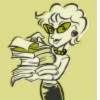 Schmidt, Gary D. 2004. LIZZIE BRIGHT AND THE BUCKMINSTER BOY. New York: Clarion Books. ISBN 0-618-43929-3
Schmidt, Gary D. 2004. LIZZIE BRIGHT AND THE BUCKMINSTER BOY. New York: Clarion Books. ISBN 0-618-43929-3In 1912, Phippsburg, Maine is replete with silvery maples, pine trees, outhouses, dirt roads, and church-goers. The citizens of Phippsburg also have their fair share of racism. Turner Buckminster discovers this head on. After spending a great day with a new friend, he is accused of consorting with a “Negress.” In fact, his new friend Lizzie Bright is the only person in the community with whom Turner feels comfortable. Even when Lizzie is not around, Turner imagines conversations with her. Schmidt creates multidimensional characters using both action and dialog. Turner is a quiet and determined young man. Though he appears to be timid, he manages well-placed quips on the town’s most intimidating characters. Lizzie’s bold spirit and down-to-earth perspective are evident. Though she is a young black girl, Lizzie walks into a white woman’s home and she freely tells Turner he needs “to get his head on straight.” The spinster, Mrs. Cobb, seems to be mean and racist, but turns out to be not so easily labeled. The plot, that of a new minister and his family moving from Boston to a small town, could be seen as typical. Also typical is the fact that the son doesn’t relate well to his new community. However, the interracial relationship and some characters’ willingness to stand up in 1912 for what is right set this book apart. Though timeless, the conflicts and triumphs in this story clearly occur in another era. Phrases such as “Golly Moses,” mention of horse drawn wagons, and the lack of amenities remind the reader this piece of fiction is historical rather than contemporary. By combining frequent dialog and first person narrative, Schmidt creates an intimacy between the reader and LIZZIE BRIGHT AND THE BUCKMINSTER BOY. Through Lizzie’s self assurance and Turner’s relentless quest for justice glimmers of hope shine through in this tragic story .
Having garnered the distinction of both a Newbery Honor Book as well as a Michael L. Printz Honor Book, this tragic historical fiction novel is highly recommended for readers grades 5-8.

No comments:
Post a Comment